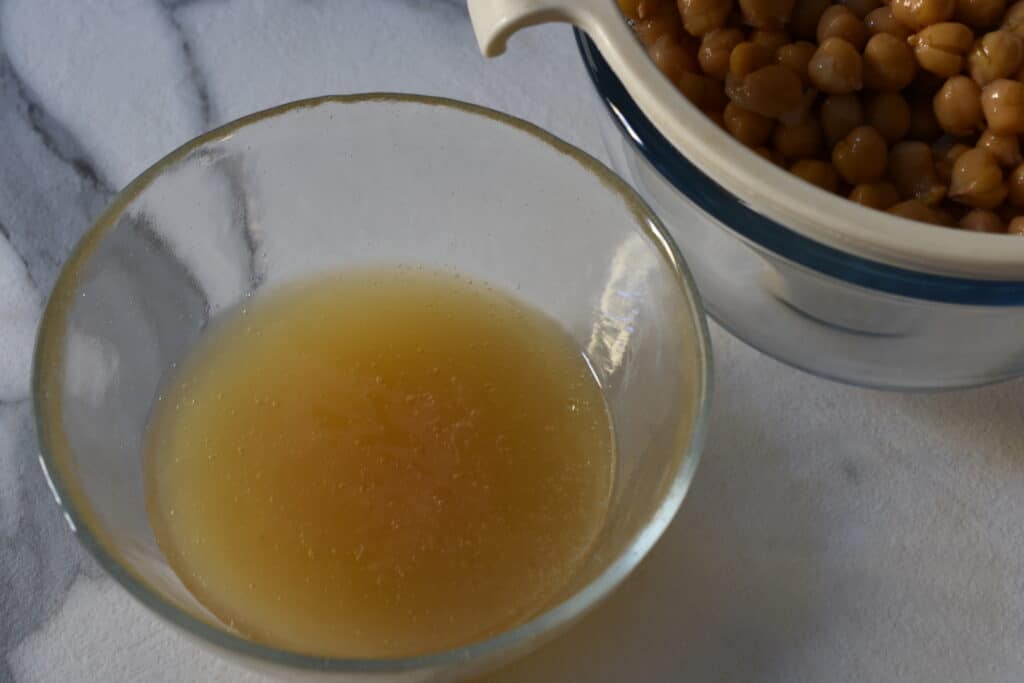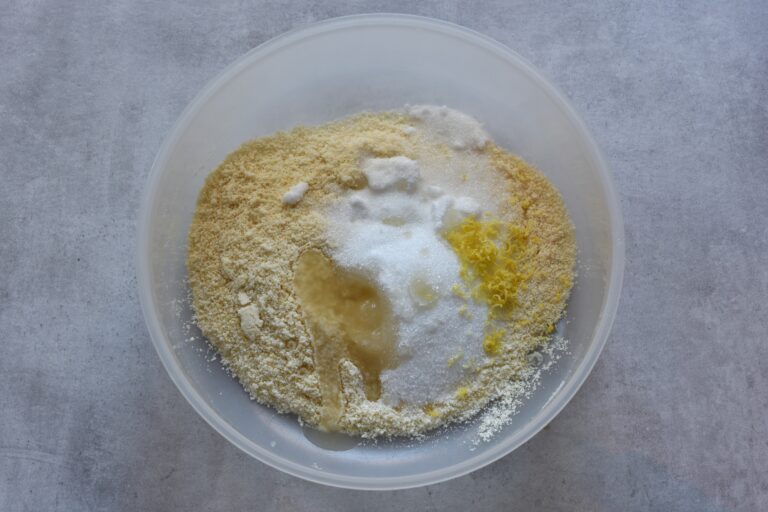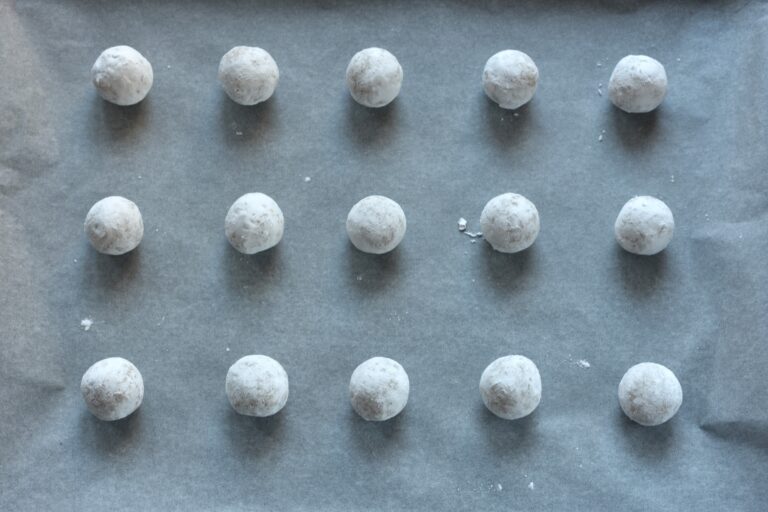You’ll love these vegan Italian almond cookies! These delightful Sicilian almond biscuits are known as pizzicotti alle mandorle in Italian, where pizzicotti means pinches and mandorle almonds. Pizzicotti alle mandorle have a delicate crumb that practically melts in your mouth! The texture is neither too dense nor too airy, striking a perfect balance. As you bite into these vegan Italian almond cookies, you’ll discover a chewy centre, which is a delightful contrast to the initial crispness. Even if I say so myself, this is the best vegan Italian almond cookie recipe – try it and find out for yourself!

These iconic Sicilian cookies are made with coarsely ground almond flour and sugar, without wheat flour or fats of any kind. That doesn’t exactly make them healthy, but they’re delicious nonetheless! Lemon zest, which is optional, balances out the sweetness perfectly, and aquafaba acts as a binder, holding everything together. These vegan Italian almond biscuits are quick and easy to prepare, with no special skills or equipment required. Wrapped up in pretty homemade packaging, they make a lovely gift for family and friends at Christmastime and on special occasions.
These Italian almond cookies are called pizzicotti because the biscuit paste is “pinched” using the thumb, forefinger and middle finger, which leaves three characteristic indentations on the top of the biscuit. I wanted to keep this pizzicotti recipe as authentic as possible but without eggs. So what you’re getting here is an authentic Italian almond cookie recipe that’s 100 % vegan and practically impossible to distinguish from the original recipe. They also happen to be naturally gluten-free.

Origins and Traditions
Originating from the sun-kissed regions of Southern Italy, where almonds flourish in the warm Mediterranean climate, these cookies are the fruits of the bounty of the land. Pizzicotti alle mandorle, with their delicate crumb and aromatic almond essence, are a testimony to traditional Italian baking. These traditional almond biscuits are often made using family recipes that have been handed down through the centuries, and skilled artisans and home bakers alike take pride in their meticulous preparation.
Almonds have always held significance in Italian culture, symbolizing good luck and prosperity. Pizzicotti alle mandorle, with their prominent use of almonds, embody this tradition, making them a popular choice for gifting during special occasions. They often make their appearance during festive occasions and special gatherings. In Sicily, they are a cherished part of feast day celebrations and weddings, symbolising good fortune and the sweetness of life.

About this recipe
As always, I like to keep traditional recipes as authentic as possible but without using animal products. So I took the most authentic recipe I could find for pizzicotti alle mandorle and substituted the egg whites with aquafaba. The recipe turned out perfect, and no one could tell that they were vegan. You’ll be able to read more about aquafaba and how to use it in this recipe below.
The thing I like most about using aquafaba is the fact it aligns with my zero-waste philosophy. Chickpea water is a “waste” product that normally gets thrown away. Using it in our recipes instead of eggs is far better than exploiting hens and costs nothing.

How to make vegan Italian almond cookies (pizzicotti alle mandorle)
The quantities indicated in the recipe card at the bottom of the page make 30 biscuits weighing 14 – 15 g each.
ingredients
Almonds
You can use either blanched (aka peeled) almonds or whole (unpeeled) brown ones. Blanched almonds have had their skins removed and are therefore white. These will yield light-coloured almond cookies. Unpeeled almonds will give them a more rustic appearance, with little brown flecks. I use blanched almonds because I love my pizzicotti to be as white as possible. Don’t try blanching your own almonds because they need to be completely dry in order for you to grind them!
I use ground almonds for convenience, as they’re readily available here in Switzerland. If you only have whole almonds, no problem! Just put them in a grinder or blender and grind them to a coarse powder (see instructions below).
Sugar
This recipe calls for castor sugar or granulated white sugar. Bear in mind that some sugars aren’t vegan. Read about the use of bone char (often referred to as natural carbon) in sugar here. In the same article, you’ll also find a list of companies that commercialise vegan sugar and the ones whose sugar is not vegan. I use Aarberg extra fine sugar, which is labelled vegan. I buy it at the Migros here in Switzerland.

Aquafaba
This is the ingredient that replaces the egg whites in these vegan Italian almond cookies. Aquafaba is the cooking water from chickpeas (or other legumes).
For those of you who are unfamiliar with aquafaba, it is what we vegans use to make meringues and lots of other goodies. It is used as a replacement for eggs and egg whites. Its composition of carbohydrates, proteins, and other soluble plant solids, which have migrated from the legumes to the water during cooking, gives it a wide spectrum of emulsifying, foaming, binding, gelatinising and thickening properties very similar to those of eggs.
I’ve written a complete guide on aquafaba with all the information you’ll ever need: how to make it from dried or tinned chickpeas; how to whip it; how to use it in savoury recipes and desserts; how to troubleshoot if your aquafaba won’t whip. Read all about it here.
Is it necessary to whip the aquafaba?
In this Italian almond biscuit recipe, it would seem not.
One day, I discovered quite by chance that whipping the aquafaba in this recipe isn’t absolutely necessary. I was making half the quantity of biscuits stated in this recipe, and when I saw the 25 g of aquafaba in the bottom of the whipping beaker, I sighed and thought to myself, I’m going to really struggle to whip such a small quantity. Because I’ll never say no to an experiment as long as I can eat the food afterwards, I decided to try to make the almond biscuits without whipping the aquafaba. In all honesty, I couldn’t tell the difference between the ones where I had used whipped aquafaba and the ones with unwhipped aquafaba.
Conclusion? If you’re curious like me and you want to experiment with whipped aquafaba, then by all means, go ahead and try it out for yourself. Otherwise, trust me, your Italian almond biscuits will turn out perfectly fine with unwhipped aquafaba.
How to use aquafaba in this recipe for vegan Italian almond biscuits
If you want, you can whip the aquafaba – it only takes a few minutes. Remember to add a small pinch of cream of tartar to stabilise it, or it will deflate after a while. Read more about that here. Otherwise, if you’re feeling lazy, just use the aquafaba straight from the jar or tin of chickpeas, without whipping it.


Almond extract
Almond extract is derived from real almonds, resulting in a genuine almond taste. Essence, on the other hand, is an artificial or synthetic flavouring that replicates the taste and aroma of almonds. Obviously, almond extract is better. Use whichever you have on hand this time, but maybe consider buying almond extract in the future for a more authentic almond flavour.
Lemon zest
Lemon zest serves to enhance the overall flavour profile of these vegan almond biscuits by introducing bright and citrusy notes. Be sure to use organic lemons or ones with an edible peel that hasn’t been treated with chemicals either during harvesting or transportation.
Icing sugar
The icing sugar (aka confectioner’s sugar) is for rolling the biscuits before they go into the oven. If you can’t find vegan icing sugar, you can use a blender or grinder to reduce normal vegan sugar to a powder.

Method
In the recipe card at the end of this post, you’ll find step-by-step instructions with photos. I recommend you read the following paragraphs before jumping to the recipe card because they contain some useful tips.
Mix the ingredients
- If using whole almonds, put them in a blender or food processor and grind them to a sand-like consistency. Don’t overgrind them, or you’ll end up with almond butter! As soon as most of the almonds are ground down to a sandy texture, stop the blender and put the ground almonds through a sieve with a coarse mesh. This will filter out the big chunks. Put the chunks back in the blender and blitz again so that you don’t waste any.
- Put the ground almonds, sugar, aquafaba, lemon zest, and almond extract into a bowl. Mix the ingredients together with a spatula or your hands to form a thick, homogeneous biscuit paste. The paste will seem a bit dry to begin with – that’s how it should be, so resist the temptation to add more aquafaba for the moment. Take the biscuit paste in your hands and squeeze it into a ball. If it holds together well and it’s tacky but not wet, it’s perfect. Wrap it in clingfilm and leave it to rest in a cool place or in the fridge for 20 – 30 minutes. Then, carry out the test in the next step.
shape the almond cookies (pizzicotti)
- Take approximately 14 – 15 g of the mixture and shape it into a ball. Press down on the ball using your thumb, forefinger, and middle finger together. The tips of your fingers will leave three indentations. The paste should be soft enough for you to do that fairly easily, with a few cracks forming as you press down. If the paste feels hard and large cracks form when pressing down, you probably need to hydrate the paste more. Add a little more aquafaba (no more than 5 grams at a time) to the paste and mix well.
- Once you are satisfied with the consistency, proceed to make the balls. If the paste is on the wet side, the biscuits will spread during cooking. They’re delicious anyway but not as attractive as they lose their characteristic “pinch” marks (see the photo below). Your goal is to get cookies that hold their shape but are soft and chewy inside.

- Roll all the balls in icing sugar, dusting off the excess.
- Preheat the oven to 180 ºC. Leave out the oven tray (solid tray, not a rack) that you will be using for the biscuits.
- Put a sheet of baking paper onto the cold oven tray and arrange the balls in 3 rows of 5. Using the method described in step 4, pinch the top of the balls to form three dents. Leave sufficient space between the biscuits because they’ll spread a bit during cooking. If making the quantities indicated below, you’ll need to do them in two batches. If you can, leave the tray with the balls on in the fridge or outside in the cold for 15 – 30 minutes – this will ensure that the biscuits don’t spread too much.
How to bake your almond cookies
- Put the cold tray with the biscuits on it in the oven and bake for 11 – 13 minutes at 180 ºC. When they come out of the oven, they will be very soft and will look a bit undercooked. That’s how they should be. They firm up as they cool down. When cold, they’ll be nice and crunchy on the outside and soft and chewy on the inside. If you overcook them, they’ll brown underneath and become hard on the inside. When they’ve cooled down, try picking one up. It should be firm and just starting to change colour underneath but still white on top.
- Put your almond biscuits in a biscuit tin and place them in the fridge for 12 hours or so. The thermal shock improves the consistency of the biscuits.

How to store vegan Italian almond cookies
Store your vegan Italian almond cookies in a metal biscuit tin with a lid in a cool place. I put mine out on the balcony in winter.
How long can you keep vegan Italian almond cookies?
You can keep your vegan Italian almond cookies for several weeks if stored correctly. I’ve kept mine for a month.
Can you freeze vegan Italian almond cookies?
Yes, you can, but I don’t really recommend doing it. The problem with biscuits, pastries, and baked goods in general is that they don’t keep very well in the freezer. They also tend to absorb the smells of other foods when stored in proximity. And, of course, the humidity makes them go a bit soft. They’re so quick and easy to make that you can afford to make them fresh every time.
I hope you enjoy these vegan Italian almond cookies! If you do, let me know in the comments below! I’d love to hear from you!
You might also like to try these other popular recipes!


If you liked my recipe for vegan Italian almond cookies, it would be great if you could rate it and leave a comment! It helps me immensely, and it also helps others discover my blog and recipes. Thank you for supporting Vegan Hot Stuff! Deborah xxx
Subscribe below to receive more vegan recipes as soon as I publish them!












Appena terminati sono andati a ruba!!!
Ottimi e gustosi.
Bene, sono contenta!